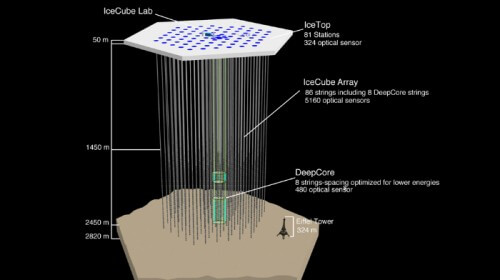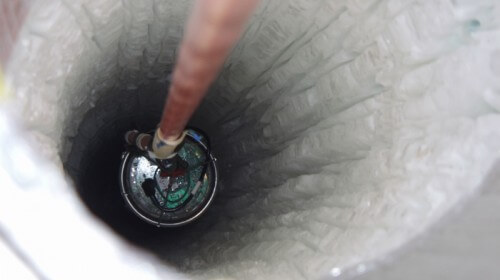High-energy neutrinos have been detected in a huge detector in Antarctica

More than a century ago, the German scientists Lisa Meitner and Otto Hann studied the processes of radioactive decay of the atomic nucleus, and discovered that something was missing. The energy released in the process did not match the expected intensity, and they were unable to explain the deficiency. Twenty years later, in 1931, the Austrian scientist Wolfgang Pauli solved the riddle - at least theoretically. He predicted that in the decay another tiny particle is released, lacking an electric charge. Pauli wanted to call the strange particle "neutron", because it has no charge, but that name was taken by a much larger particle discovered a few years earlier. The Italian physicist Enrico Fermi gave the new particle the name "neutrino" - which means "little neutron" in Italian. It took more than 20 years of research before two American scientists, Clyde Cowan and Frederick Reines (Cowan & Reines), were able to verify Pauli's prediction, and prove that a neutrino particle was indeed created in nuclear fission.
An elusive particle
A neutrino is an extremely strange particle, because it does not react with almost any matter. It moves almost at the speed of light (but not faster, as was mistakenly published two years ago) and does not react with almost any matter - it easily passes through mountains, oceans and entire galaxies. From the moment you started reading this article, many trillions of neutrinos passed through your body without you feeling at all. There was someone who thought that to stop neutrinos, a lead wall much thicker than the entire solar system was needed...
If the neutrino is so elusive, how can it be detected? Its reaction with matter is a very rare event, but since there are so many neutrinos around us, the quantity is sufficient to detect some of them in a suitable detector. When the neutrino does react with something, tiny light is produced. very tiny Much less than the billionth of the power of a normal light bulb. Detectors capable of receiving this light intensity are used to detect the neutrinos.
Secrets from deep space
Most of the neutrinos around us are created in the immediate environment: atoms are constantly decaying in a natural process, and many particles also come from decays in the atmosphere and the sun. However, there are also neutrinos that come from much greater distances, after being released in cosmic explosions in the depths of space, such as the explosion of stars known as "super-novae", or events known as "gamma ray bursts", the nature of which is still unclear. Since high-energy neutrinos are much rarer, detecting them requires instrumentation of a different order of magnitude. It has to be very large (to increase the chance of discovering relatively rare particles), and it has to be transparent, so that the detectors scattered in it can pick up the faint light of the neutrino decay. The most suitable medium is ice (or water), and therefore the giant detector was built deep in the ice of Antarctica, very close to the South Pole.
More of the topic in Hayadan:
- Guests from the edge of the universe
- Science on ice
- Construction of the IceCube Antarctic neutrino telescope has been completed
The detector, known as IceCube, actually consists of 86 strings, on each of which 60 sophisticated light sensors are assembled, each in a ball slightly larger than a basketball. Each such chain was lowered into a shaft about 2.5 km deep, to create a cubic kilometer cube, consisting of 5,160 detectors, the upper part of which lies one and a half kilometers underground (see diagram). The detector was completed about two years ago, at a cost of about 240 million dollars, in collaboration with several institutions around the world, led by the American National Science Foundation (NSF). Now researchers report in the journal Science that during two years of observations, at least 28 extremely high-energy neutrinos, with energies of more than 30 teraelectron volts (Tev), have been detected in IceCube. Two of them had an energy of more than 1000 TeV - and the researchers have no doubt that these particles were not created in our immediate environment. With such enormous energy, they could only be charged in distant and extremely powerful cosmic events, having an energy of more than 30 teraelectron volts (Tev). Two of them had an energy of more than 1000 TeV - and the researchers have no doubt that these particles were not created in our immediate environment. With such enormous energy they could only be charged in distant and extremely powerful cosmic events. "This is a new era for astronomy. We already look at the universe not only through light rays (for example, visible light, radio waves or other forms of electro-magnetic radiation), but also through neutrino particles," says Dr. Hagar Landsman-Fels from the Weizmann Institute of Science, who participated in the development and establishment of IceCube detector. "The neutrino will provide us with more information about cosmic radiation; about very energetic explosions occurring in space such as gamma ray bursts; and about other energetic phenomena that occur outside our galaxy".

Expect surprises
For the time being, the researchers have not yet been able to match the intensity and direction of the particles that were discovered, to a cosmological event known to us. In other words, they still don't know exactly the origin of the neutrinos detected in the detector. Such adjustments - they hope - will be possible in the future. If it doesn't happen at IceCube, it might very well happen at the next-generation detector that Landsman-Fells and her colleagues are currently working on designing. Unlike IceCube, the new detector known as Askaryan Radio Array (ARA), will not be based on light detectors, but on sensors of radio waves, which are also created by the reaction of neutrinos with matter. The radio waves progress better in the ice, so fewer sensors per unit of area will be needed and it will be possible to deploy the detector over a larger, shallower area. The new detector should be much less complex from an engineering point of view, because it does not require drilling to a depth of 2.5 km but only a few dozen meters, and also much less expensive than its predecessor. The researchers hope that it will also yield fascinating observations, and deepen our ability to understand phenomena that we cannot see, far in the depths of space. In addition, says Landsman-Fells, every time scientists build such a complex device with new capabilities, we also discover things we did not expect to find, sometimes with surprising applications. It is very possible that it is precisely in the ice of the southern depths that we will discover surprises from space.

4 תגובות
It may be possible to identify the direction based on the location of the activated light sensor (the sensors are scattered around the tank and detect the flash of light from inside the tank, at least that's what I understand)
I agree with Arnon's question, according to what I understand, the detector can only detect whether or not a particle hit it, how are you supposed to detect the direction from that?
It is not clear how the detector gives the direction from which the particle came.